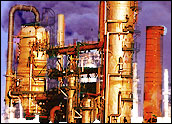
For U.S. consumers, this week’s big news is that the average price of gas fell below $2 a gallon nationwide — at least for now. But prices aren’t even everywhere in the country. In Mississippi, for example, the AAA says the average price is US$1.94 per gallon. In Southern California, the Automobile Club of California says a gallon of regular averages $2.34.
It’s the petroleum supply chain that gets your gas to the pumps. Like any supply chain, it has the same source, create and deliver model. But unlike others, the petroleum business involves huge amounts of liquid of varying grades that must be contained and transported to highly involved and interdependent operations that start with raw oil and end with the delivery of numerous finished products — only one of which is the gasoline that runs your automobile. And in the middle, there’s an incredibly complex manufacturing process.
Long Supply Chain
Steve Banker, service director, supply chain management (SCM) at the Arc Advisory Group, a consulting and research firm, explained to CRM Buyer that the price of gas has to do with the costs and profitability of the supply chain, as well as the fact the oil and gas are traded at almost any point throughout it.
“It’s not unusual for a tanker of unprocessed oil to be traded several times on the ocean,” he said. “It can also be traded at the refinery, in the pipelines, or at the distribution terminals.”
Dwight Klappich vice president of supply chain research at Meta Group, told CRM Buyer in an interview that, unlike other supply chains, the supply-chain path from crude oil to the consumer is extremely complex, and the linkages between raw crude and consumer must be managed over long times — usually many weeks.
Banker’s supply chain view is different. Despite the oil industry’s long supply chain, the portability of oil and gas in effect makes for a shorter supply chain, he explained. This means that trading considerations — political stability, OPEC rulings, terrorism, or expecting an unusually hot summer — all affect the price significantly.
In addition, Banker observed that in turbulent times about one-third of the cost of a gallon is driven by trading considerations — or what traders believe will happen in the future — and two-thirds by the normal costs and margins of the supply chain. During less turbulent times, with a more predictable future, supply and demand trading considerations become much less influential on price, he said.
SCM’s Role
According to Klappich, the leaders in the petrochemical supply-chain-management market include a handful of companies, including SAP, Aspen Technology, i2 Technologies, and Manugistics Group.
“None of them have the market nailed,” Klappich noted. “For example, one might be better at the transport area, another at demand-and-supply planning.”
Pat Swafford, petroleum supply chain product manager at Aspen Technology, said that he sees the oil supply chain as having three basic areas: raw materials supply; manufacturing and product optimization; and supply and distribution.
“Each segment has its own challenges,” Swafford said.
According to Swafford, a Gulf Coast refinery purchasing a tanker for raw crude from Saudi Arabia may wait as long as two months as it crosses the Atlantic. Along the way, companies make production decisions based upon the quality of the resource and the shifting economics of production he said. SCM helps with the logistics, scheduling and making decisions to buy, sell or trade the cargo, he added.
Constant Optimizing
“Optimizing the process is not a single event but an ongoing process to continually evaluate the raw materials coming and determining how the fluctuating economics impact the margins for the refinery and others along the supply chain,” Swafford continued. “Our solution is about maximizing the margins for those in the supply chain so that they know which of the nearly infinite products they can produce from their raw materials.”
Swafford went on to say that, during the manufacturing phase, the value of the materials can change quickly — requiring decisions to be made about which products can provide the best margin. The supply-and-distribution phase is simpler because it is more about scheduling and having the products in the right place at the right time. SCM software assists in managing challenges along the entire product path, he noted.
Consumer Impact
For his part, Klappich said that because the oil business deals with a nonrenewable resource it is ruled by two things — the classic economic laws of supply and demand and the many physical constraints placed upon it. To be successful, integrated systems, business processes, and collaboration supply-chain-management systems are essential.
“As a nonrenewable resource, oil scarcity drives the price up. A higher price at the pumps is something Americans should get used to seeing,” Klappich said.
Meanwhile, Aspen Technology’s Swafford said that SCM software can help keep the processes tighter and provide some impact on consumers, but the economic variability in the chain has a larger impact on them.
Business Constraints
The oil business also operates under physical constraints, Klappich also said. One of the constraints is that North America refineries have a limited capacity, and it is uncommon that capacity is met, so oil must be bought someplace else to make up the difference.
Another constraint is that many more things are made from raw crude than gasoline. “Consumers frequently forget that it is also the basic resource for plastic, pharmaceuticals, pesticides, clothing, cosmetics, nylon, agricultural fertilizers and many other oil-based products that touch our lives every day,” Klappich noted.
To track consumer prices at gas stations, the Southern California Auto Club monitors credit-card swipes at the pumps electronically collecting and analyzing the purchases at the 2,800 gas stations in the area by zip codes.
Southern California Auto Club spokesman Jeffery Spring detailed some of the supply side constraints driving his state’s prices higher than others. The demand for gasoline by Californians is 45 million gallons a day, but the state’s refineries can only produce 43 million, he told CRM Buyer.
The difference means going to another refinery that can process gasoline according to California’s unique specifications. “There are only two — one in Northern Europe and another in the Middle East,” Spring said. “And we have to make it attractive for them to sell to us, and this means higher prices at the pumps.”
Shift to Ethanol
Last January, California added another constraint that oil companies must manage when doing business in the state. Now ethanol must be mixed into the gas to replace a proven carcinogen, methyl tertiary butyl ether (MTBE) that has been used previously.
But ethanol changes the formula for gas and requires more gas than the previous requirements — further reducing the amount available, Spring explained.
Although taxes are included in gas prices, Spring said their role is less in California than other states because its gasoline tax only ranks among the top one-third of the nation.
“With fuel prices vacillating, one of the trends we’re seeing is that carriers, like UPS and others, are starting to consider adding fuel surcharges to their deliveries so that a rising cost of gasoline isn’t eating into their margins,” noted Klappich. “There’s even talk in the airline industry of surcharges on plane tickets.”
This story was originally published on June 15, 2004, and is brought to you today as part of our Best of ECT News series.





















































